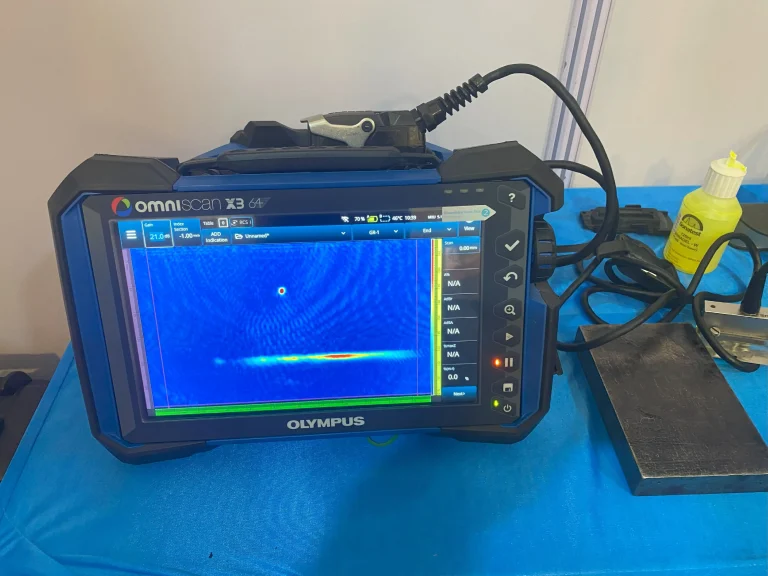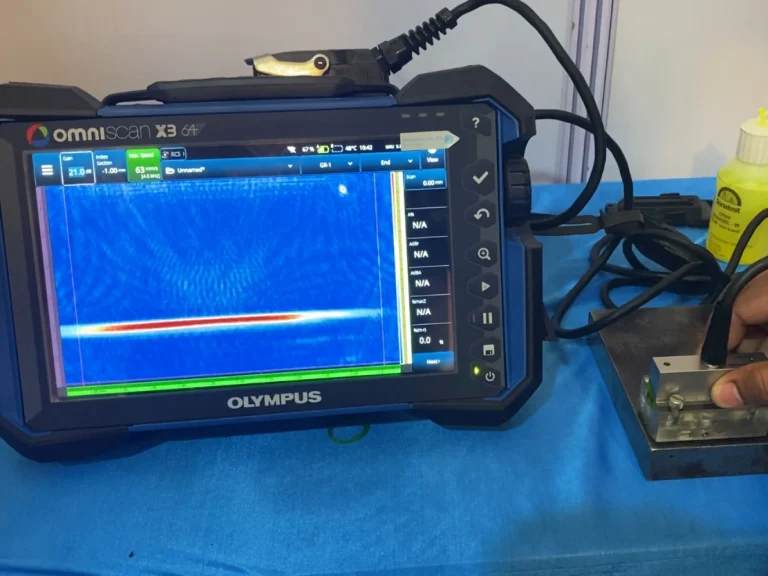Phase Array Advanced Ultrasonic Testing Services in Bangalore
PAUT Level II Certified Inspectors. In-house ASNT Level III Experts.
Experienced professionals for PAUT of Welds. Pipe line, Pressure Vessel UT.
Phased Array Ultrasonic Testing Services in Bangalore. PAUT weld inspection experts. Pipleline, aerospace advanced NDT Labs.

Phased Array Ultrasonic Testing Solutions in Bangalore
We have added Phased Array Ultrasonic Testing (PAUT) solutions. With this, we are the the first NDT Lab at Bangalore, India to serve on advanced NDT solutions. State of the art ‘Olympus make’ model OmniScan X3 PAUT equipment is a brilliant, reliable to scan welds to find minute flaws. This helps us to serve our customers in meeting the fabrication code requirements. Capable to perform scanning of welds on pressure vessels, pipelines and other fabricated structures to international standards.
With our equipment, vast experience in performing PAUT inspections onsite, there is no chance of missing a single flaw. Easy solution to radiography testing safety problems. Facility for phase array A-scan, B-Scan, S-scan. Recording of indications to present to end customers for review.
Our advanced NDT services division engaged in providing weld inspections using PAUT technique. Serving at our labs. Onsite NDT services in the state of Karnataka. Trinity NDT – NABL accredited ultrasonic services agency since 2001 serving 1500+ clients in India.
If you are looking for PAUT solutions near Bangalore, we are ready with our experienced inspectors, state of the equipment. Contact us today.
Why choose our PAUT Services?
Phased Array Ultrasonic Testing – a disruptive technology that is changing the landscape of ultrasonic testing. Applications in oil, gas, power generation, pipe line fabrication, petrochemical companies. Our PAUT experts perform testing, interpret the results and submit detailed reports.
Since 2001, Trinity NDT provides testing and welding inspection services to clients across India. We offer reliable services on Phased array UT inspections. Customer choose us for
- Over 2 decades of experience
- quality, reliability, committed team of experts
- State of art equipment from ‘Olympus’
- Experienced PAUT Level II inspectors
- Expert in-house ASNT Level III
- Equipped with latest standards in Phased Array UT
- Approved procedures as per ASME, ISO, API
- On-time, competitive best pricing
- Aerospace quality systems,
- OEMs approvals
- 5 Star rated NDT services since 2001
Introduction to PAUT

Many individuals are familiar with the day to day medical applications of ultrasonic imaging. High-frequency sound waves are used to create highly detailed cross-sectional images of internal organs. Medical sonograms are made with specialized multiple element probes known as phased arrays. But the applications of ultrasonic phased array technology (PAUT) are not limited to medical applications.
In recent years, phased array ultrasonic systems have been increasing in use in industrial applications to provide new levels of information. It also provides, visualization in common ultrasonic tests that include weld inspection, bond testing, thickness profiling, and in-service crack detection.
During their first couple of decades, commercial ultrasonic instruments relied entirely on single element transducers. Probes used one piezoelectric crystal to generate and receive sound waves. Dual element transducers that had separate transmitting, receiving crystals. Also, pitch-and-catch or through-transmission systems that used a pair of single element transducers in tandem.
These approaches are still used by the majority of current commercial ultrasonic instruments designed for industrial flaw detection and thickness gaging; however, instruments using phased arrays are steadily becoming more important in the ultrasonic nondestructive testing (NDT) field.
Evolution of Phased Array UT
The principle of constructive and destructive interaction of waves was demonstrated by English scientist Thomas Young in 1801. It is a notable
experiment that utilized two point sources of light to create interference patterns. Waves that combine in phase reinforce each other, while waves that combine out-of-phase cancel each other Phase shifting, or phasing. This is in turn a way of controlling these interactions
by time-shifting wavefronts that originate from two or more sources.
It can be used to bend, steer, or focus the energy of a wavefront. In the 1960s, researchers began developing ultrasonic phased array systems that utilized multiple point-source transducers that were pulsed so as to direct sound beams by means of these controlled interference patterns. In the early 1970s, commercial phased array systems for medical diagnostic use,first appeared using steered beams to create cross-sectional images of the human body.
Principle of PAUT
Conventional ultrasonic transducers for NDT commonly consist of either a single active element that both generates and receives high- frequency sound waves, or two paired elements, one for transmitting and one for receiving. Phased array probes, on the other hand, typically consist of a transducer assembly with 16 to as many as 256 small individual elements that can each be pulsed separately. These can be arranged in a strip (linear array), 2D matrix, a ring (annular array), a circular matrix (circular array), or a more complex shape.
PAUT works just like conventional ultrasonic principle. That is, energy reflects at different acoustic impedance containing materials. The only difference is using multiple cystals that fire at different timings so as to steer the wave in required direction.
Frequently, the elements are pulsed in groups of 4 to 32 in order to improve effective sensitivity by increasing aperture, which then reduces
unwanted beam spreading and enables sharper focusing. Software known as a focal law calculator establishes specific delay times for firing each group of elements in order to generate the desired beam shape, taking into account probe and wedge characteristics as well as the geometry and acoustical properties of the test material.
The beam can be dynamically steered through various angles, focal distances, and focal spot sizes in such a way that a single probe assembly
is capable of examining the test material across a range of different perspectives. This beam steering happens very quickly so that a scan from
multiple angles or with multiple focal depths can be performed in a fraction of a second.
Check Our Other NDT Services
- NABL accredited NDT testing service
- Radiography x-ray testing
- Eddy Current testing
- Ultrasonic Testing UT Service
- Magnetic particle inspection
- Demagnetization service
- Dye penetrant Testing
- Visual Welding Inspection
- ASNT, NAS410 Level III consulting
- Welder Qualification certification
- Certification courses on NDT and Welding
- Aerospace NDT Services
- NADCAP accredited Aerospace Labs
- NDT Level II, Welding Inspector training

